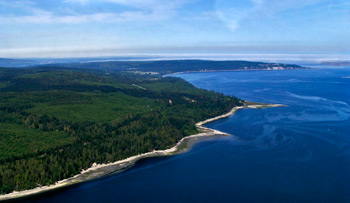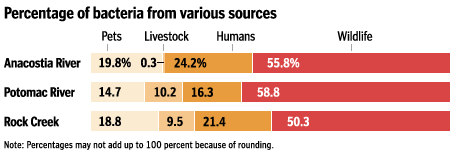Jefferson County Clean Water District
 |
In 2007, the Jefferson County Board of County Commissioners enacted an ordinance forming a clean water district, using an $18.00 per parcel fee for funding, placing it on a fast track so that the fee could be collected beginning with property tax bills in 2008.
The clean water district was formed in response to a transient elevated level of fecal coliform bacteria finding at the southern end of Discovery Bay in 2007, which led to the temporary downgrading of a commercial shellfish bed. The state required the county to establish a shellfish protection district as a result of the downgrade. As on option, the county instead chose to establish a clean water district covering all of eastern Jefferson County as a means of addressing the issue, and to provide funding for a program that would help protect other commercial shellfishing areas of the county.
While supportive of high-quality, cost-effective water quality monitoring to help us determine what problems may exist and where, the Olympic Stewardship Foundation opposed the funding mechanism and the inclusion of the entire eastern portion of the county to address an isolated incident in Discovery Bay. Monitoring is necessary not only to identify issues that need work, but also to demonstrate where our environmental stewardship is producing good results. It also provides a crucial role in ensuring the quality of shellfish production, one of Jefferson County's most important industries.
We withheld our support for several reasons, including but not limited to:
- A per-parcel fee is one of the most regressive forms of funding possible, and there were other viable funding mechanisms that were not being pursued.
- The program as envisioned assumed the problem was caused primarily by failing septic systems and domestic animal waste, even though research indicates that wildlife are most often the majority fecal coliform bacteria contributors.
- The process leading to the commissioners' vote on the proposed enacting ordinance was characterized by an unseemly degree of haste, made necessary by a deadline for getting the per-parcel fee on the next property tax billing. (We believe that public policy made in haste is generally poor public policy.)
- The Board of County Commissioners had already signed a Centennial Clean Water Fund grant agreement with the Department of Ecology to correct the problem in the southern portion of Discovery Bay.
Fecal Coliform Sources in Three Urbanized Rivers  Source Dr. Charles Hagedorn, Virginia Tech
|
Microbial source tracking (MST) of the fecal coliform bacteria that cause degradation of shellfish beds plays an important role in helping target solutions to the actual causes of the contamination. The accompanying examples from the region in and around Washington, DC illustrates the issue. If nearly 60% of the fecal coliform contamination found in the Potomac River as it flows by the nation's capitol comes from wildlife sources, what are the percentages likely to be found here in Jefferson County, where have far different wildlife-to-human ratios on the landscape than they do at the bottom end of the Northeast Corridor?
We don't know . . . and we should, before we start spending our hard-earned money no solutions unlikely to fix the problem.
The Olympic Stewardship Foundation recommended that the Board of County Commissioners should take a deep breath, step back, and begin a more deliberative approach to developing a clean water program with the assistance of a working group comprised of county staff and interested citizens. This would provide the opportunity to develop a program that meets the water quality needs of the many environmental stewardship programs throughout the county in a far more comprehensive and cost-effective manner.
The county opted not to collect the fee, relying instead upon other funding sources and a scaled down version of the program they had planned to implement.
In August 2009, in response to the loss of funding and the additional challenges posed by the current economic climate, the commissioners amended the county code to enact a clean water district fee set at $5.00 per parcel, far less than the originally planned $18.00 per parcel. The fee was first collected with property taxes in 2010.
